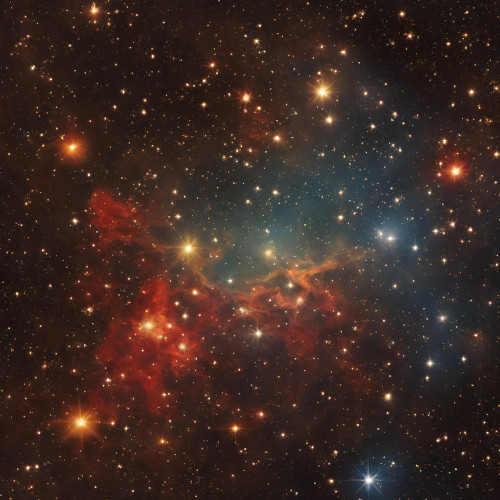“We assume that’s where we came from.”
Almerandi teaching about the galaxy in the sky
The Array

The Array is an open cluster of over 100,000 star systems, about 130 parsecs wide, essentially a small satellite galaxy around a vastly larger barred spiral, 30,000 parsecs away. In much of the Array, the larger Galaxy (the Splay) dominates the ‘western’ sky.

Stars in the Array are not rotating in a disc, but are grouped amorphously. There are dense and sparse regions throughout, but the tendency is that stars thin out as you approach the periphery.
The types of stars are distributed roughly as they are in our galaxy, with about 15% of the stars being main sequence yellow stars like the Sun, and most of the rest being red dwarfs. There are also red and blue giants, white dwarfs, neutron stars and even black holes.
The Array also has nebulae. Some gas clouds are still the sites of star formation. There has also been one supernova in recorded history that disrupted the systems in its vicinity. None are anticipated to happen in the next thousand years.
Worlds
The Arrival was preceded by a series of of seed ships over thousands of years, culminating in humaniti coming to the Array. Many worlds that were uninhabitable became the targets for these Outsider processors that modified their conditions to prepare them for humans and the other life that was sent with them. By the time humaniti arrived, thousands of planets in the Array had atmosphere codes in the range of 5 – 8, and in the last 10,000 years, they have terraformed even more planets. Most sectors in the Array have at least one world that has standard atmosphere, and some sectors, especially towards the Core, have several.
Indigenous Life
Before the arrival of humaniti, the majority of the systems in the Array had no life. On the worlds where it did exist, the Array had its own native life, mostly in two separate genetic lines. This had spread across the cluster, by panspermia, over the course of a billion years, to planets from more than 10% of the systems.
Spore
One genetic line resembles what we would recognize as fungus. Universally they are called the ‘Spore’, reproducing with a similar mechanism to Outsider fungi, and never developing ambulatory movement. On many worlds, this was the only line that had taken root at the time, and it existed on over ten thousand worlds back then. These spore had evolved to fit in a multitude of evolutionary niches. Their biological byproduct has a reflecting long-term cycle, where sometimes Spore produces CO2, and at other times, oxygen, and also some solvents and other trace gasses. Large forms of the spores exist, like mushrooms, but none has developed a circulatory system, or intentional mobility.
Spore of some kind are now on roughly half the worlds of the Array, often on multiple planets in the same system. Almost all spore spread since the Arrival has been with humaniti from planet to planet. There are millions of catalogued classifications within the genetic line, and the drugs synthesized from some of these can have long-term effects that still aren’t fully explored.
Mainly, spore fit into ecosystems where they break down organic matter in the soil, water and even air. With humaniti, some spore that would have remained isolated have been identified and cultivated, so that they are now widespread, and in some cases, nearly ubiquitous.
Flower

The other genetic line, the ‘Flower’, has the potential for mobile forms evolving, leading to indigenous (what we would call alien) animals existing on hundreds of worlds. The animals, or ‘blooms’, are usually the mobile phase of a stationary flower, in the life cycle of a plant-like organism, that stays in one place, using variously: photosynthesis, geothermal heat, tidal forces, and even wind and hydrology, in order to grow and develop, before one or more pods develop over time. Eventually, from each pod an animal Bloom form is birthed, only alive for a short time (usually a few years at most). This allows the animal to find and prepare a place for its reproductive phase. This animal phase uses stored energy from the pod phase at first, before relying on consumption of other life forms (even other animals) to supplement the photosynthesis and other energy sources they can rely on during rest/recharge.
The stationary growth phase of a flower is always by far the longest.
Spread and Extinction
Humaniti has spread indigenous life to other planets in the Array, often by accident, so that more planets have indigenous species now than before the Arrival. At the same time, Outsider life and terraforming have caused indigenous life on some worlds to go extinct, as the changing conditions became inhospitable.
Other Indigenous Forms
Two other indigenous lines in the Array are known to exist, but each is unique to its own world, not having spread to other planets.
Outsider Life
With the Arrival came thousands of Outsider species of life that had the same origin as humaniti, including plants, animals, fungi, and various single-celled organisms and even viruses. These life forms were cultivated by automated seed ships over many thousands of years, first the microscopic life, then larger organisms, to multi-cellular organisms, ever to larger forms of life. Even cetaceans were able to survive on at least three worlds. Humans were the last additions to the Array, and their introduction marked the end of the Arrival.
Once humans began to spread from world to world in the Array, they brought with them Outsider life, and this has proceeded for over ten thousand years. Terraforming has continued as well, once Array cultures had the technology, and currently, tens of thousands of worlds have become host to some sort of Outsider organism. Animals especially have evolved over the time since the Arrival, to fit their new planets. Humaniti learned of husbandry and breeding on many worlds, and accelerated this process.
And humans are not exempt. A planet that has had a people living on it for many thousands of years will sculpt its inhabitants. As they say about the Shadari, “They survived the hell and tamed it,” but only by adapting. The Unsaag of the Dominion live on a high gravity world, and so tend to be slightly shorter and stronger than average humans, with a grayish cast to their skin, while their associated Glinde are tall and tanned. Almerandi have developed pale skin, due to living mostly out of the sunlight. Sallumini are often tan, and have very tough feet (Salan IV is barefoot-friendly). Trienese have olive complexion from their thick atmosphere and bright sun.

